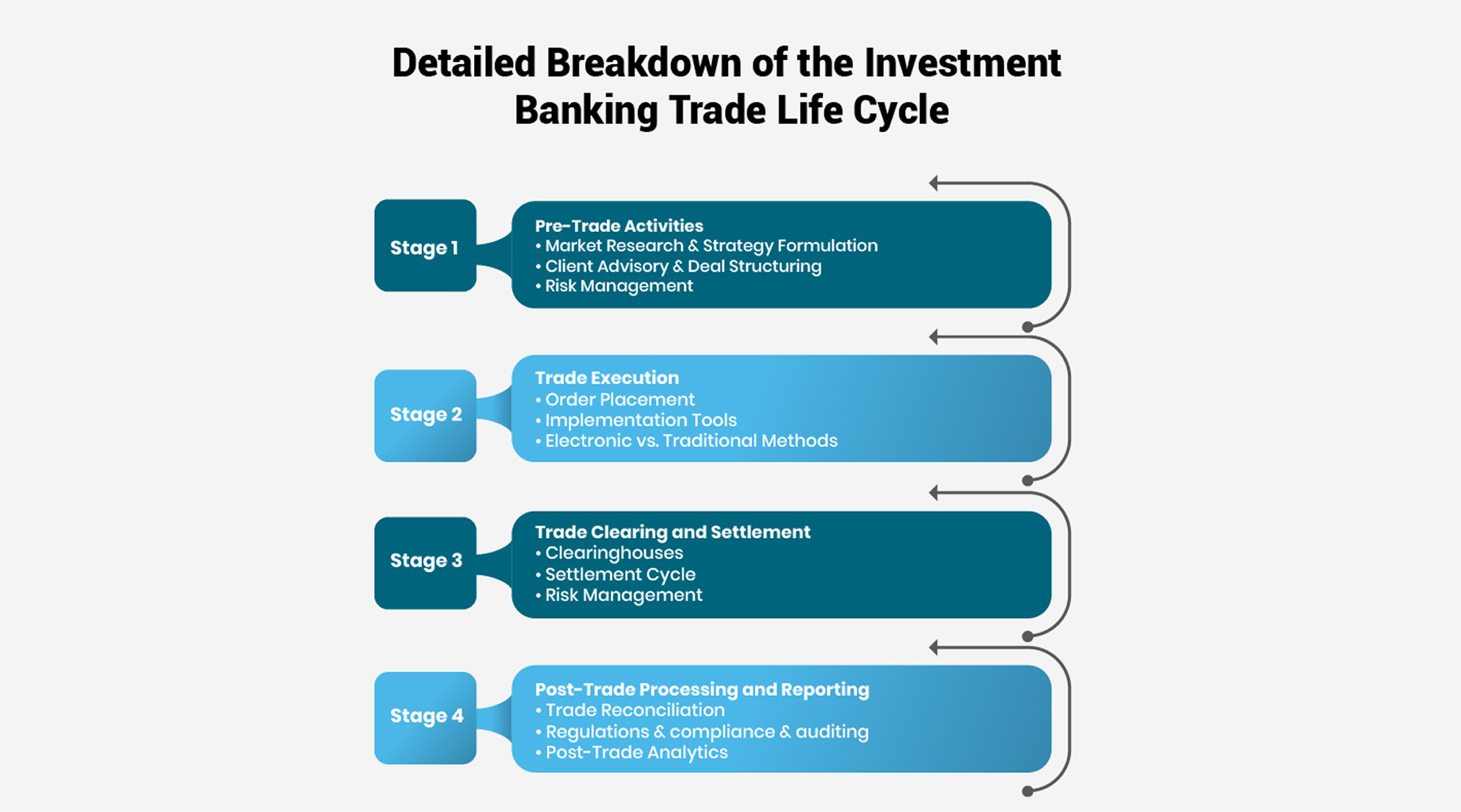Introduction
The trade life cycle in investment banking is a key financial market structure that governs trading performance, amendments, and completion. Trade is a process that involves purchasing or selling goods and services and passes through a particular sequence known as the trade cycle. They are involved in risk management, legal compliance, and the smooth flow of deals in the global markets. An effective trade lifecycle creates a healthy pace of business, reduces risks in its operations, and keeps the market stable. Financial personnel, speculators, and the stakeholders in the decentralized capital markets must comprehend this process.
Trade Life Cycle in Investment Banking
The trade life cycle involves the entire trade process in investment banking, including— but not limited to— the execution and settlement of trade to ensure efficient flow in the capital markets. It includes integrated functions to meet efficiency, quality, and legal requirements.
This process operates across three divisions: the front office, the middle office, and the back office:
-
Front Office—Trade Execution: This stage involves implementing a trade, which includes buying or selling a security. The front office creates opportunities to buy and sell securities and ensures that orders are passed at the best and most available price. This stage employs real-time decision-making, which involves using algorithms and data analysis.
-
Middle Office—Risk & Compliance: This middle-office role involves monitoring all trades to ensure their validity and compliance with the rules and regulations formulated by relevant regulatory authorities. It comprises identifying risks, complying with internal and external policies, and auditing trade risks. The role checks with the middle office the trade aligns with the bank’s current strategy and transaction conditions.
-
Back Office – Settlement & Clearing: Once the trade has been carried out and both counterparties accept it, the back office becomes active. Some of them include validity checks, checking for any discrepancies in the transaction, and ensuring that settlements are made on time. Clearinghouses assist in reducing risks to an extent by confirming trades and facilitating the exchange of securities and cash.
Detailed Breakdown of the Investment Banking Trade Life Cycle

Stage 1: Pre-Trade Activities
Pre-trade is an essential phase of investment banking, covering the most critical part of planning and strategizing before the trade occurs. This is the research and analysis phase, where an investment banker produces a framework based on market-proven conditions to satisfy clients’ requirements.
-
Market Research & Strategy Formulation: Investment bankers research the markets, industries, and firms in the economy to make business choices. They also apply complex financial forecasts to gauge future performance.
-
Client Advisory & Deal Structuring: Investment banks help clients make prudent financial choices regarding M&As and capital management.
-
Risk Management: It involves assessing risks to determine which trade best suits the prevailing market conditions and the client's risk-taking level. Legal issues are also addressed at this stage to avoid future compliance issues.
Stage 2: Trade Execution
The next step is operating a plan where orders are placed and carried out in the marketplace.
-
Order Placement: Once the decision is made, the order is placed on various exchanges, either manually or via automated systems.
-
Implementation Tools: Trading desks are required to have the implementation of trades. They deal with institutional investors and market participants and ensure they have a schedule for completing their work.
-
Electronic vs. Traditional Methods: While traditional floor trading still exists, electronic trading platforms provide faster execution, real-time updates, and greater efficiency.
Stage 3: Trade Clearing and Settlement
Following the trade execution, the clearing and settlement phase involves completing all financial transactions.
-
Clearinghouses: These organizations act as central depositories ensuring each party fulfills their contract.
-
Settlement Cycle: Settling of the transaction includes the exchange of assets and payments and usually takes about T+2 days. This helps actualize trades without any chances of a default on a particular deal.
-
Risk Management: Investment banks take margin calls and collateral management measures to minimize settlement failures.
Stage 4: Post-Trade Processing and Reporting
The last step is to get confirmation of the executed transactions and generate a report.
-
Trade Reconciliation: Banks ensure that both sides of a trade match by assessing the transactions carried out.
-
Regulations & compliance & auditing: Investment banks and their managers are also under much pressure from the regulators with the submission of reports for auditing purposes.
-
Post-Trade Analytics: Investment banks utilize post-trade analytics to analyze execution outcomes trends and make necessary adjustments to future trades.
Technology’s Role in the Modern Trade Life Cycle
Technologies have improved business processes and influenced the trade life cycle in investment banking. Each change enhances trade execution, compliance, and settlement through automation and advanced analytics. The following are some of the impacts of technology on investment banking:
-
Algorithmic Trading & AI: AI automates processes and sells securities faster than humans, attempting to capture the best price without affecting it. Trade strategies depend on analyzing current business information using predictive analytics.
-
Blockchain & Smart Contracts: Blockchain makes trade settlements secure, eliminating risks associated with counterparties and providing a sealed recordation. Smart contracts help automate the trade confirmation and reconciliation process.
-
Risk & Compliance Automation: Artificial Intelligence is used to prevent and report the existence of fraud and other compliance risks that are detrimental financially.
-
Trade Processing Upgrades: Cloud front and back office and trade settlement, eliminating manual intervention in post-trade processing.
Regulatory Framework Governing the Trade Life Cycle
The role of regulation in investment banking is also significant. Regulation keeps the process transparent by controlling risk and providing fair trade practices. The trade life cycle is always keenly regulated, mainly to protect buyers and sellers from fraud and ensure the stability of the markets.
Key Aspects of Regulatory Oversight:
-
Trade Execution Compliance: Bank traders are responsible for executing business at the best price to help the client achieve maximum profit. Primary supervision is placed on the use of particular channels and routeways through which trades are conducted.
-
Clearing and Settlement Regulations: Clearing houses minimize credit risks by implementing mandatory margins and meeting capital adequacy standards. Real-time trade confirmations have proven to decrease settlement failures.
-
Post-Trade Transparency: Those regulatory bodies require transparent reporting of particular trade acts that involve time stamps of trades, details of counterparties, and classes of assets, among others. This assists in keeping records and checking instances of fraud in the market, which affects the stocks through manipulation.
-
Emerging Regulatory Trends: Most evolving regulations involve trading through algorithms and automated trading. Regulators are taking measures such as audit trails and real-time monitoring to capture transaction irregularities. Striking for shorter settlement periods also aims to minimize credit and operations risks.
Conclusion
Investment banking activities occur in stages, including origination and deal execution. The trade life cycle in investment banking helps improve efficiency in capital markets, risk management, and compliance. Technological innovations are already impacting trade execution, clearing, and meeting regulations. In financial markets, investment banks must go through the innovation process with good corporate governance to ensure stability, better performance, and client satisfaction.

